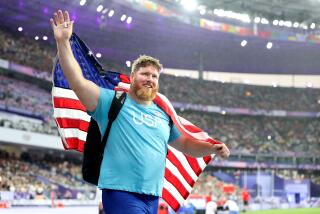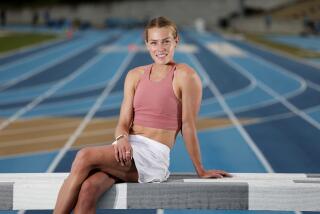Giving It Her Best Shot : Despite Injuries, Shot Putter Bonnie Dasse Has Made It a Habit to Look to Next Year
- Share via
The world according to Bonnie Dasse, for the last nine years, has revolved not around the sun but around a metal ball that weighs eight pounds and 13 ounces. Her sphere of existence has been defined by a sphere the average astronomer, or even the average man, knows little about.
The shot put has been her universe.
In the last two years, she has watched her world transform from what was nothing but unorganized matter waiting to develop, into a career that apparently has transcended time and, seemingly instantaneously, placed her on a par with the best women throwers in the nation.
And in the last two years, while Bonnie Dasse has watched her world speed along and rise to meteoric heights, she also has watched it crash desperately back to earth at precisely the wrong moment. Injuries, coming at such inappropriate times that they would seem to have been planned by her opponents, have at times made the shot an almost impossible weight to bear. Atlas had it easy compared to her.
You wouldn’t blame her if she became tempted to hoist the object of her frustrations one last time, disgustedly hurl it somewhere without bothering to see how far it went, and never again pick it up. It has been that bad.
But so far, she has chosen to respond in a more pragmatic way. Dasse’s resilience has been tested severely this year and last, but both times she has shown her elasticity. Whether she can recover physically from her current wrist injury has yet to be determined. But her ability to recoup her emotional strength remains unquestioned.
“It’s not fun,” she said of the knowledge that this season is all but over for her. “I’ve been through that before. You’re always going to go through a little mourning period, no matter what.”
This year, the time for grieving occurred just after last month’s U.S. nationals in Indianapolis. Dasse had attempted to come back after hurting her left wrist in February and reinjuring it in May. She tried to throw, realized she couldn’t without risking greater injury, and pulled out of the meet. And as a result, she found herself left off the U.S. team, which was selected from the nationals for the European season.
While Ramona Pagel and Peggy Pollock, her biggest American rivals, were happily preparing to compete in West Germany, Switzerland, France and elsewhere, a dejected Dasse sat at home in Costa Mesa, trying to suppress thoughts of the meets she could not look forward to.
“I really wanted to go to Europe this year,” she said, her voice almost a whisper. “Thinking about those people going to Germany, and I wasn’t going . . . if I thought about that, I’d probably jump off the (Westin) South Coast Plaza Hotel.”
She was, of course, only joking. But beneath the jocularity was a certain seriousness.
“If I had a lot of time to sit and ponder it,” she said, “I’d be really depressed. But I can bounce back pretty quick.”
Less than a week later, she had done so. A trip to tranquil Seeley Lake, Mont., far removed from the congestion of Southern California, did the trick. Dasse went there to work at a track and field camp, but her two-week stay served a more important purpose. She returned mentally refreshed, the despair of Indianapolis not quite forgotten, but no longer constantly haunting her.
“I can rebound very quickly,” she said, echoing the prediction she’d made a few days before. “My first day there I was 100% different. If I can get in the right environment, I can snap out of things. My priorities have already changed. I’ve already set my sights on next year.”
Which sounds strikingly similar to last year’s discouraging turn of events.
It was not until 1983 that Dasse began to make herself known on the American scene. Before then, her personal record had been just 47-feet 9 3/4-inches (the American record at the time was 62-7 3/4). But she finished fourth at nationals in June of ‘83, and by December her best mark was up to 55-8 3/4.
Then she suffered two stress fractures in her vertebra, and though she didn’t realize it at the time, her ’84 season was ruined. Thinking the injury would disappear, she continued to train and compete and even extended her personal best to 56-2 1/2 in April. But it caught up with her. In the Olympic Trials, she placed eighth, and her season was finished. Dreams of the Olympics remained dreams.
“That was very traumatic,” she said. “Without a doubt, I could’ve been on that team. It was my fault for not resting my injuries. It was stupid. I was competing hurt, but that’s how I was. I didn’t know any better.”
The experience gave her a dose of perspective she badly needed. It was what told her she must forget about this year’s nationals, because to compete would have been a grave risk. Regardless of how far she might have thrown at Indianapolis, Dasse was aware that it might have been devastating had she reinjured her wrist.
“I would ordinarily never pull out of a meet,” the graduate of Costa Mesa High School and San Diego State said. “But I’ve learned that it’s the long run that matters. That’s a very valuable lesson. I have a little more self-control, a little more self-discipline.”
And her new-found qualities now are evident to those around her.
“She knows she has to rest,” said Lorna Griffin, a close friend of Dasse’s and the second-ranked discus thrower in the country. “She knows she can’t overdo it and she’s going to be smarter about it.”
While she maintains hope that she’ll be invited to several international meets later this summer, Dasse has discarded the notion that the future is now. A year ago it would have been someone else, not Dasse, who would have said, “I’d just as soon rest, scratch the whole season and go for next year.”
But today, those are her own words. Dasse realizes that in all likelihood it won’t be until 1986 that she’ll be at her physical peak again. And when she is, her throws should go farther and farther, if this year means anything at all.
“When you try so hard, you get pretty frustrated,” Pagel said. “That frustration last year motivated her to throw 62-6 this year. That same frustration is going to be there next year.”
Last December, Dasse broke 58 feet. By January, she’d broken 59. By February, 60, by March, 61. Then, in a meet at UC Irvine in May, she took her personal best out to 62-6 3/4, just an inch short of the American record set by Maren Seidler in 1979.
But Dasse was not merely battling Seidler. More importantly, she was racing Pagel to the record. For months they were inches apart, or even less. They still are.
In April’s U.S. track and field rankings, Dasse was the top-ranked American at 61-6. Pagel was a half-inch behind her. In May, it remained exactly the same. In June, Dasse moved up to 62-6 3/4, but Pagel kept the pressure on, ranking only an inch behind her. Dasse and Pagel owned the top 10 throws of the year in the May and June rankings, and no one was close to them.
But neither Dasse’s lead, nor Seidler’s record, lasted long. On May 26, Pagel threw 62-9 at UCLA. And when the July rankings came out, Dasse was second. She could only watch in frustration, because by this time she was unable to compete.
“I know I could’ve hit it easily,” she said of the record. “I can equate where I would have been according to her. That’s how close we were. But that’s how it goes, I guess.”
Assuming Dasse is at full strength next year--and that may be a dangerous assumption--the rivalry should continue. It should be Pagel vs. Dasse and the rest of the field watching.
“It motivates both of us,” Dasse said. “Knowing Ramona is right there on my heels, I can’t slack off. I need that constant pressure behind me--or in my case, in front of me.”
Said Pagel: “It pushes us both a little harder to throw farther than we think we’re capable. It’s a race, rather than just trying to break the record.”
And she wants it that way. As Kent, her husband and coach, said, “It’s going to get awfully lonely otherwise. The conquest comes from having somebody to conquer.”
But Pagel has only Bonnie Dasse to conquer in the United States. For Dasse, there is much more than the specter of a familiar opponent standing between her and her goals. There is the seemingly endless challenge to remain injury-free. And thus far that has been an obstacle much larger than the 6-0, 190-pound Ramona Pagel.
‘I’ve learned that it’s the long run that matters. That’s a very valuable lesson. I have a little more self-control, a little more self-discipline.
More to Read
Go beyond the scoreboard
Get the latest on L.A.'s teams in the daily Sports Report newsletter.
You may occasionally receive promotional content from the Los Angeles Times.










